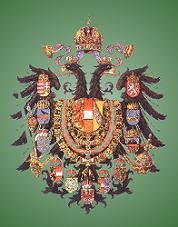The Belle Epoque in Europe
Austria
Vienna
Metropolis of the Belle Epoque
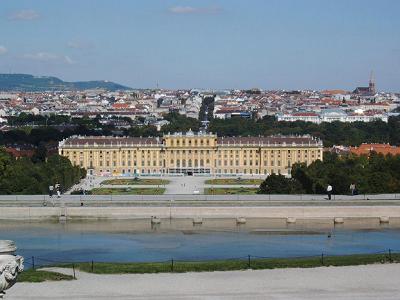
During many centuries, Vienna has been the majestic capital for the emperors of the Holy Roman and Germanic Empire but in the course of the XIXth
century, Vienna had to take two heavy blows shaking and changing his position in Europe lastingly:
In the beginning of the XIXth century already, in 1805, the third coalition war against Napoleon ended by the defeat of Austria in the so-called
Three emperors battle of Austerlitz leading to not negligible territorial losses in the Peace of Pressburg (Bratislava); on the 6th of August 1806,
after an ultimatum by the French emperor, Franz IInd of Habsburg renounced the crown of the Holy Empire. Even if Austria under the leadership of
Prince Metternich became stabilized after the Vienna congress in 1814/15 arising again as a territorially coherent state, the lasting consequence remained
that the ancient German emperor, since 1804, was nothing more than the emperor of the Austrian hereditary empire.
The second blow was the Austro-Prussian war in 1866 aiming at the predominance of Germany ending with the Austrian defeat of Königgrätz. Subsequently,
Bismarck succeeded to dissolve the German Federation (Deutscher Bund) and to found the German Empire (Deutsches Reich) under the Prussian supremacy without Austria.
This defeat and the forced separation of the other German states led however to a reorientation and reorganization of the Danube monarchy, and in 1867, by the compromise
with Hungary, Franz Joseph Ist founded the dual monarchy Austria-Hungary.
In spite of those military and political blows arose the Belle Epoque of Vienna. Between 1867 and the First World War, Vienna was - besides Paris - the splendid and
magnificent capital of Europe. Since the Fifties already, the development of Vienna advanced rapidly under the reign of Franz Joseph Ist; the first incorporations
of the surrounding towns into Vienna were executed (1850-61), the city walls were destroyed (1857) and the Ringstraße (perimeter road) was built instead (1861)
where many public buildings were erected - ministries, museums, the Opera and the Court Theatre. The utilities engineering of drinking water was improved (1870-73) and
the first horse tramway put into service (1865). In the Dommayer casino, Johann Strauß the Younger played valses of Vienna, in Grinzing and Hietzing, people were
sitting and drinking the Heuriger (new wine), Johannes Brahms conducted the Wiener Singverein (Vienna choir 1872), Anton Brucker passed his exam in music theory in
the Piarists church (1861) to become afterwards university professor (1875), and in 1873, the Seventh World Fair took place in Vienna. In the course of the second urban
extension in 1890/92, Vienna became a city of over a million inhabitants; in 1892, the construction of the Stadtbahn (underground) began which from 1894 onwards was led
by the architect Otto Wagner. And in 1895, the christian-social lawyer Dr. Karl Lueger was elected mayor
of Vienna.
Epoch's turning point: The year 1897
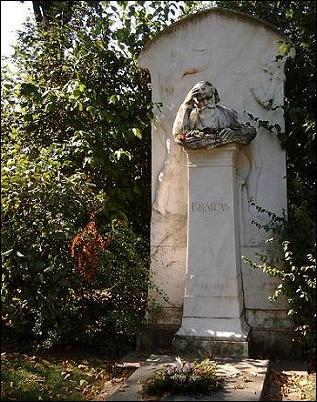
Dr. Karl Lueger, on one hand, was a shady, dubious popular orator using an indecent anti-Semitism to fight his political opponents; although follower of the Habsburg
dynasty, he was opposed to the dual monarchy and did not speak less scornfully about the Hungarian citizens than about the Jews. Therefore, Franz Joseph Ist
refused several times to confirm his election as Vienna's mayor until Lueger in 1897 was elected for the fifth time so that the emperor felt he could not ignore the
people's decision anymore. On the other hand, Lueger promoted the development of Vienna in an extent that the people of Vienna, nowadays, consider Lueger being some
sort of super-mayor: He pressed ahead with the extension and municipalization of the utilities engineering of drinking water, gas and electricity to make Vienna independent
of private search of profits, ordered the creation of the forest and meadows area around the city, the foundation and extension of the public transports and the electrification
of the underground.
1897, moreover, was the year when Johannes Brahms died and Gustav Mahler was appointed as director of the National Opera. Shortly before,
Mahler was converted to catholicism because born as a Jew he would not have had any chance for such an appointment in spite of his genius. When Brahms died on the 3rd
of April, the ancient times died whereas on the 11th of May 1897, with the famous performance of Lohengrin at the opera, a new era was born. From 1903 onwards,
to realize his idea of Richard Wagner's Gesamtkunstwerk (total work of art), Mahler worked with the painting and decorating artist
Alfred Roller being a member of a group of young avant-garde artists who, in the same year 1897,
left the conservative Künstlerhaus in order to realize a modern art, new in a radical manner, and therefore they founded the Vereinigung Bildender Künstler
Österreichs Secession (Union of Fine and Graphic Artists of Austria Secession).
The Secession
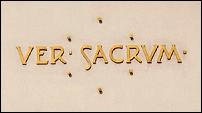
Besides Alfred Roller, among others, members of this group were Gustav and Ernst Klimt,
Koloman Moser, Josef Hoffmann and
Joseph Maria Olbrich. They followed the examples of the Munich and Berlin Secessions, the first one
found in 1892 already, the latter one starting in 1893. Secession is an expression coming from the Latin secessio plebis meaning the people retiring from the
government affairs in times of bad reigns. The Secession symbolized the rupture with the traditional conservatism in the teaching of that time and an alternative to the
Academy: The diversity of the cited and varied historic shapes should be replaced by a new style corresponding to the new age: "To the Age its Art - To Art its
Freedom", such was the Secession's motto. Moreover, on the wall of the Secession's Exposition Hall, built in 1897/98 by
Joseph Maria Olbrich, you can read Ver Sacrum, Holy Spring, symbolizing the new artistic start.
From 1898, the Secession published a magazine under this title in order to let a large public know about the new artistic ideas.
Moreover, regular expositions took place in this hall where not only the art work of Secession members but also of many foreign artists was shown; two of these
expositions had a particular importance for Vienna:
- The VIIIth exposition in 1900 was dedicated to the austere artistic shapes of the Glaswegian artist Charles Rennie Mackintosh who subsequently influenced the Vienna scene far more than the curved floral motifs from Paris, Brussels or Munich which left more distinct traces in Prague, Budapest or Ljubljana. In Vienna, you don't find any artist who devoted himself exclusively to this floral Art Nouveau. The school of Otto Wagner, determining the architectural style, represents a more austere style, nearly classicistic. The Exposition Hall itself, in spite of its rich floral ornamentation, followed this example. For the time being, the ornamentation had not yet lost its importance regarding exterior decorations; sometimes it even seems to be exaggerated, marble, majolica, coloured tiles, metal applications, gold and so on are used oftenly and in a luxuriant way.
- The XIVth exposition in 1902 under the direction of Josef Hoffmann is considered to be the climax of the secessionist search for the Gesamtkunstwerk to which all arts should contribute. It was dedicated to the composer Ludwig van Beethoven, the heart of the exposition was the Beethoven frieze of Gustav Klimt, one of the masterpieces of the Secession's art.
Architecture had become the leading art, so the architects reached an importance never known before and therefore a corresponding self-confidence as artists. They did not simply want to erect buildings anymore, but their aim was the architectural Gesamtkunstwerk where they designed and decorated the interior as well as the garden up to the very last decorative detail. The way leading to the realization of this Gesamtkunstwerk was made easier by the foundation of the Wiener Werkstätte (Vienna Workshop) in 1903 by Josef Hoffmann, Koloman Moser and Fritz Wärndorfer, the Wiener Keramik (Vienna Ceramics) in 1906 by Michael Powolny and Berthold Löffler as well as the Wiener Mosaikwerkstätte (Vienna Mosaics) in 1908 by Leopold Forstner.
Spokesperson and first president of the Secession became Gustav Klimt. In 1900, another group of artists left the Künstlerhaus association and founded the Hagenbund which, in 1902, opened the doors of its own exposition hall, the Zedlitzhalle, built by Josef Urban. This extension of localities was an opportunity of free development to the painting arts. Otherwise than the decorative arts depending much on architecture, painting art could develop itself autonomously. Artists like Gustav Klimt, Carl Moll, Wilhelm Bernatzik, Ferdinand Andri, Josef Engelhart, Egon Schiele, Koloman Moser, Franz Matsch, Oskar Kokoschka, Ludwig Heinrich Jungnickel, Alfred Roller and Leopold Forstner were determining the painting and graphic style of the Austrian Jugendstil.
It is an often discussed question if the development of the modern art and architecture in Vienna at the turn of the century can really still be called Jugendstil or Art Nouveau respectively. The geometric austerity and the clear simplicity of so many works seem to prove the contrary, but the joy of ornamentation which you can see so often reaffirms the Jugendstil. There lived, nonetheless, an architect whose works constituted without any doubt the "interface" to the modern art of the XXth century: Adolf Loos (1870-1933), who polemized in numerous writings and speeches (Ornament and Crime) against superficial decoration and spoke for an austere and functional architecture.
Besides the Steinhof church by Otto Wagner, the second monumental Gesamtkunstwerk of this epoch is said to be the
Palais Stoclet (1904-11) in Brussels where, together with the architect Josef Hoffmann, famous artists, amongst them Gustav
Klimt, Leopold Forstner, Richard Luksch, Franz Metzner, and workshops of decorative arts created an ensemble of utmost perfection.
Since the renovation achieved in 2000, by speaking of Gesamtkunstwerk, one must in no way forget to mention the church of Saint Charles Borromew upon the
Central Cemetery.
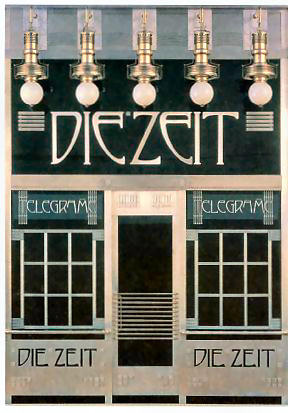 Otto Wagner (1841-1918)
Otto Wagner (1841-1918)Depeschenbüro Die Zeit (1902)
Rekonstruktion
© Wien Museum
